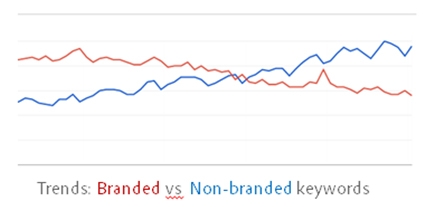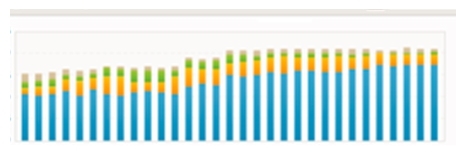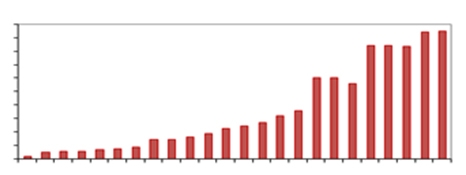In one of the previous blogs we looked at Search Impact Lifecycle and how a structured model can help SEO managers approach changes in search landscape and effectively drive SEO projects in large enterprises. Changes in search patterns can influence SEO and overall business content strategy. For example, shift in search trends from Branded (keywords that include company or product name) to Non-branded keywords suggests creation and optimization of content focused on themes built around these new search terms, for example, topics about specific product features and functionalities. Let’s take a look at the following case study.
Analysis of Branded and Non-branded keyword trends for one of the product showed an increasing trend towards use of Non-branded keywords (please see chart below, representing aggregate search volume for value keywords in both groups). This analysis is performed in the initial, “Change” phase of the SEO LifeCycle.  Once we completed the analysis and identified opportunities, we created a POV, got a buy-in, and planned a pilot, when we created 15 pages (SEO-localizing these in 14 Geos) focused on specific product features, targeting high-value Non-branded keywords. In the implementation phase, we optimized and published pages, focusing on user experience. We ensured that Tech SEO was addressed (page template coding, URL naming convention, page indexing, Geo Targeting, etc.). We also tested and selected best-performing Title and Meta Description messaging to maximize CTR from search results and worked on creating cross-links to these new pages from select theme-relevant pages to enhance user experience and also help page indexing and theme.
Once we completed the analysis and identified opportunities, we created a POV, got a buy-in, and planned a pilot, when we created 15 pages (SEO-localizing these in 14 Geos) focused on specific product features, targeting high-value Non-branded keywords. In the implementation phase, we optimized and published pages, focusing on user experience. We ensured that Tech SEO was addressed (page template coding, URL naming convention, page indexing, Geo Targeting, etc.). We also tested and selected best-performing Title and Meta Description messaging to maximize CTR from search results and worked on creating cross-links to these new pages from select theme-relevant pages to enhance user experience and also help page indexing and theme.
Search engines indexed the new pages, established theme relevancy and we started to see a steady progress over time for the main SEO KPIs. When analyzing the impact, we looked at the visibility of target Non-branded keywords, using BrightEdge SEO platform. Specifically, we were interested in progress of rankings of preferred landing pages on first page of Google search results (blue area on the bar-chart, screenshot below).
 Chart: page visibility in Google (source: BrightEdge platform)
Chart: page visibility in Google (source: BrightEdge platform)
We also tracked business SEO KPIs including visits, trials and units sold, using Adobe web analytics platform. Pages dedicated to Non-branded optimization started to contribute to the business with an increasing pace. Contribution of these pages to the overall SEO of the project increased from about 4% of all SEO visits in the first three months of the pilot to over 60% of SEO visits for the project after two years.
 Chart: page visibility in Google (source: Adobe web analytics platform)
Chart: page visibility in Google (source: Adobe web analytics platform)
Based on the impact case study, we proceeded to identify additional opportunities and expanded content themes and optimization to cover more feature details, and also expand optimization to more Geos.
What’s next: In future posts we’ll cover other case studies on how Search Impact Lifecycle allows to steer SEO projects easier, including Technical SEO, Geo Targeting, SEO testing, and more.

